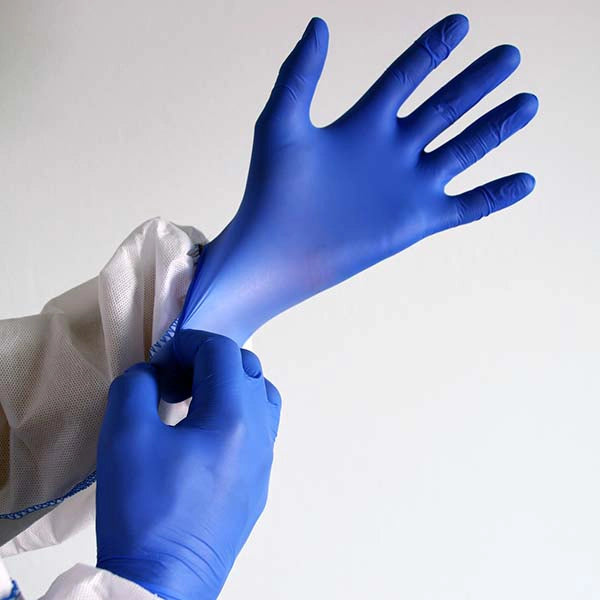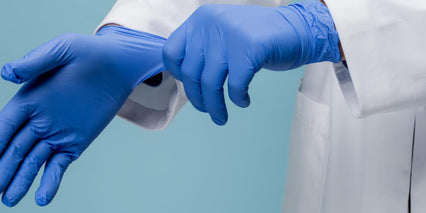The demand for disposable gloves in all industries have increased heavily due to the COVID-19 pandemic. People are paying closer attention to sanitation and cleanliness on a daily basis. Latex gloves are designed to protect all parties involved in high-risk situations and even lower-risk tasks.
What are sterile latex gloves usually used for? What are the advantages of latex gloves? Can you sanitize latex gloves? What type of latex glove will give the best protection against exposure to blood, bodily fluids, bacteria, and viruses?
In this complete guide to latex gloves, we answer all those questions and more. We'll also give you a list of the best latex gloves on the market so that you can be confident in what product to buy.
What is Latex?
Latex is a natural material derived from the rubber tree. The harvesting process of latex dates back to ancient civilizations who used latex as glue for boats and water vessels. As early as 4000 BC, natives were using the sap from rubber tree trunks to plug holes in canoes.
Benefits of Latex Gloves
Sterile latex gloves are usually used for surgical procedures and other invasive medical procedures. Treating patients in high-risk situations involving bodily fluids, blood, and infectious diseases require sterile latex surgical gloves.
Latex disposable gloves can also be used for non-invasive low-risk, general procedures including non-surgical medical procedures. They are a popular choice in both the health care industry and industrial industry. The wide range of uses include dental, medical, child care, senior care, food service, food processing, janitorial, public health sanitation, automotive, and manufacturing.
A major benefit of latex gloves is that they are disposable. This means that after a single use or a period of hours, the gloves can be disposed of and replaced. This significantly helps to reduce bacterial and viral transmission rates in medical settings. They are also effective in preventing the transmission of certain diseases such as AIDS, Hepatitis B, and C via blood or bodily fluids.
Disposable latex gloves are also very affordable and accessible to all industries large and small.
What are Latex Gloves Used For?
The primary use of latex gloves is to protect against, bacteria, viruses, blood, and bodily fluids. The goal of disposable latex medical gloves is to prevent cross-contamination between patients and physicians. They provide a great deal of dexterity which is why they are also used outside the medical community for auto repair, meal prep, and catering.
What is Used to Make Latex Gloves?
Latex gloves are made of natural rubber offering the highest comfort, flexibility, and tactile sensitivity. This is important for nurses, doctors, dentists, surgeons, and health care workers who prefer using high quality medical grade gloves. The natural rubber fiber used to make latex gloves also make them biodegradable.
Natural rubber trees harvested throughout the world are used to make latex gloves. These trees are harvested and latex is extracted, purified, and processed into a glove.
Types of Latex Gloves
Latex gloves come in various types, each designed to suit different needs and applications. The most common types are powdered and powder-free latex gloves.
Powder vs. Powder Free Gloves
The two types of latex gloves on the market are powder and powder-free. There are pros and cons to each making them ideal for different situations.
Powdered Latex Gloves
Powdered latex gloves have cornstarch inside that make them easier to slip on and off. This prevents the gloves from sticking to your hands, especially when they are sweating. While keeping your hands cool and dry, they are also more resistant to rips and tears than powder-free gloves.
These gloves are lightly powdered to provide an extra layer of comfort and prevent the hands from sticking together. You get more dexterity with powder gloves due to the powder making it easier to grip things.
Powder-Free Latex Gloves
Powder-free latex gloves will not leave a messy residue on your hands, tools, or equipment. They are popular in the food service industry for this very reason. The powder-free option is prevalently used in the medical field since the FDA ban on powdered surgical and medical exam gloves in 2017.
The powder-free glove option prevents powder from getting into woulds or exposed tissue slowing down the healing process. This is the main reason why the FDA banned powdered examination and surgical gloves.
The lack of cornstarch is also beneficial for people with latex allergies. The only downside to these gloves is that they are more likely to rip and tear than powdered gloves. It is important to also note that manufacturers today have developed ways of making non-powdered gloves that are easier put on and take off. This is good news for those with latex allergies who need to use powder-free latex gloves.
How Long Do Latex Gloves Last?
The amount of hours and uses latex gloves can handle depends on a number of factors. The main factor that determines how long your disposable latex gloves will last is the environment you are using them in. If you are using them in the hospital or medical setting, you can get about 4-6 hours out of one pair. If the environment is more demanding or high risk like food service, then you can expect to get 12-24 hours from one pair.
What Do Latex Gloves Protect Against?
Latex gloves provide a high level of protection against various hazards, making them a popular choice in many industries. They protect against:
Biological Hazards
Latex gloves are effective in protecting against bacteria, viruses, and other microorganisms. This makes them ideal for use in medical settings, laboratories, and any environment where there is a risk of exposure to infectious agents.
Chemical Exposure
While not resistant to all chemicals, latex gloves offer good protection against many common chemicals and solvents, such as cleaning agents and certain laboratory chemicals. They are often used in settings where there is a need for moderate chemical resistance.
Cuts and Abrasions
Latex gloves provide a barrier that can help protect the skin from minor cuts, abrasions, and punctures. This is particularly useful in industries such as food handling, maintenance, and healthcare, where there is a risk of skin injuries.
Contamination
By creating a barrier between the hands and various surfaces, latex gloves help prevent contamination of clean environments and protect the user from coming into contact with contaminants. This is crucial in food preparation, medical examinations, and sterile environments.
Allergens and Irritants
Latex gloves can protect the skin from allergens and irritants, reducing the risk of allergic reactions and dermatitis, especially in environments where irritants are commonly present.
Overall, latex gloves are a versatile protective measure, providing reliable defense against a range of biological, chemical, and physical hazards, ensuring safety and hygiene in various applications.
Are Latex Gloves Medical Grade?
Latex examination gloves are sterile or non-sterile medical grade gloves. They provide protection against exposure to blood and bodily fluids. Latex surgical gloves are sterile higher quality medical grade gloves. They provide the highest protection against exposure to bodily fluids and blood.
Sterile vs Non-Sterile Gloves
The biggest difference between sterile and non-sterile gloves is the AQL or acceptable quality level of pinholes. Sterile gloves have a lower AQL than non-sterile gloves.
Sterile Gloves
Sterile gloves are primarily used for surgery. There are stricter standards on sterile gloves making them more expensive than non-sterile gloves. Sterile gloves must meet FDA standards based on the AQL.
Non-Sterile Gloves
Non-sterile gloves are used for anything that is considered a non-surgical procedure including examinations. This also includes medical procedures that do not require the wearer to touch or come in contact with blood or bodily fluids.
How Are Non-Sterile Gloves Sterilized?
Someone else besides the glove manufacturer sterilizes non-sterile gloves. After sterilization, they are tested by the FDA to ensure they meet the standard assurance level (SAL) for sterilization techniques.
For non-surgical procedures, non-sterile gloves have been found to pose no higher risk of infection in comparison to sterile gloves. They are the most cost-effective solution for non-invasive procedures. For this reason, non-sterile latex gloves are the most widely used in many fields.
Can You Sanitize Latex Gloves?
Disposable latex gloves are designed to be used once and discarded. While there is one study concluding they can be disinfected with 60% isopropanol alcohol, this was only tested on four different brands of latex gloves. Only 2 of the brands tested successfully after disinfecting less than ten times.
It goes on further to state “Disinfection of these gloves is admissible e.g. after indirect patient contact, taking blood samples or laboratory work if no visible contamination or perforation has occurred. However, after contact with patients suffering from an infectious disease or carrying multiresistant organisms the gloves have to be changed. The same holds true if the gloves might be contaminated with naked viruses (e.g. Poliomyelitis virus), since virucidal alcoholic hand disinfectants require high concentration thus leading to materials incompatibility.”
Can You Reuse Latex Gloves?
Latex gloves are single use disposable medical devices. They are considered a class II medical device and need to be labeled with expiration and sterilization information by the manufacturer.
It is much safer to throw disposal gloves away after each use. Do not wash, disinfect, or reuse them. Wash your hands before and after using the gloves to further protect yourself and others.
Do Latex Gloves Protect Against Chemicals?
The best protection latex gloves provide is against bacteria and viruses. While they protect well against blood borne pathogens, they are not very chemical-resistant. Nitrile gloves and vinyl gloves are the superior choice for protection against chemicals.
What Kind of Gloves Do Hospitals Use?
Examination and surgical are the two types of medical gloves used in hospitals. Latex gloves have the most stretchy feel and offer more precision for surgeons. However, due to the increase of latex allergies, many medical providers are choosing latex-free alternatives. If you have a latex allergy, nitrile gloves are the better choice.
Beware of the cost though. Synthetic nitrile gloves cost more than latex gloves. The lower cost of natural latex makes these medical gloves a cost-effective solution for the level of protection offered.
What are Disadvantages of Latex Gloves?
The biggest disadvantage are latex allergies. They can cause allergic reactions on the skin and offer little chemical protection. It can be hard to detect lacerations and puncture holes which is why many doctors and surgeons practice double-gloving.
Double Gloving
Many healthcare professionals and laboratories wear two pairs of sterile gloves during sensitive procedures to lessen the risk of infection and exposure to bloodborne pathogens. The outer gloves acts as barrier to protect the inner glove from perforation. Using different colored gloves can protect you even further by discovering small penetrations by sharp tools sooner.
Does Glove Color Matter?
Originally, hospital gloves were just two colors to identify which gloves were latex and which were latex-free. Now, medical professionals use color to help detect punctures. Wearing a darker glove or a lighter colored glove is a common double-gloving practice. You will see the light colored inner glove through the darker outer glove if it should tear.
Is Double Gloving Recommended?
To get the best protective value from latex gloves, it is highly recommended to wear two pairs of gloves on each hand. Layering a dark color glove over a light color glove makes this even easier. Need more proof?
In this study, it was found that “The addition of a second pair of surgical gloves significantly reduces perforations to innermost gloves.” It goes on to conclude that “Perforation indicator systems results in significantly more innermost glove perforations being detected during surgery.”
In another study, it was discovered that using two pairs of gloves, instead of just one pair, reduced the number of perforations in gloves by 71%. It also found that blood stains on the skin were reduced by 65%.
Choosing Latex Gloves
Here is a list of the best latex gloves on the market. Compare the features and benefits of each to help you decide which one is best for your current needs.
In case you didn't know, all products listed above can be found in our store at competitive prices. Save money while effectively preventing cross-contamination and protection from harmful bacteria and viruses. We also sell latex gloves in bulk.
We hope you found this complete guide to latex gloves useful in deciding what types of gloves are best for your situation. Be sure to check out this other resource comparing the difference between nitrile and latex gloves.
Where to Buy Latex Gloves?
When looking for high-quality latex gloves, it’s essential to choose a reliable and reputable supplier. gloves.com is one of the best options available, offering a wide range of latex gloves suitable for various applications, including medical, industrial, and household use. They provide gloves that meet stringent quality standards, ensuring durability, comfort, and excellent protection.
At gloves.com, you can find powdered and powder-free latex gloves, exam-grade and industrial-grade options, and different sizes to fit your needs. Their easy-to-navigate website and excellent customer service make purchasing hassle-free, ensuring you get the right gloves quickly and efficiently.
Choose gloves.com for your latex gloves and experience top-notch products and service that meet your safety and hygiene requirements.






